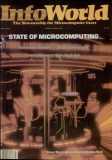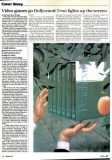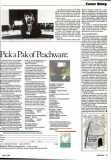Video game fantasy becomes Hollywood reality in a new movie from Walt Disney Productions called Tron, to be released July 9. In this futuristic adventure, the age-old battle between good and evil is staged on a videogame grid inside a giant computer.
Besides having a computer-related theme, the film itself makes extensive use of computer animation as a setting for live-action characters.
The story is set in two worlds; the real world, where the computer system in a communications conglomerate is controlled by a single program and a dictatorial executive, and an electronic world inside the computer. Inside the computer, the master control program takes on the (evil) nature of the executive, and the alter egos (mainly good) of other programmers within the company are personified by the programs they have written.
The conflict with the computer arises when a former programmer at the company believes his game software has been pirated, and he decides to hack into the system to find out why and by whom. Through electronic wizardry and computer-generated imagery, the characters themselves are transported inside the computer to travel throughout its circuitry.
The movie is not only exciting but extremely topical, given the proliferation and popularity of video games nationwide. Disney estimated that 12% of all Americans play video games.
The force behind Tron, its creator and director, is video-game enthusiast and animation specialist Steven Lisberger. He and producer Donald Kushner approached Walt Disney with a plan for Tron in mid-1980. They had been researching the technology involved in producing computer-aided animation, and Disney put up the money for a demonstration short film. After seeing the demo, Disney executives okayed full production.
Although Tron is an adventure epic, Lisberger feels there is an added dimension in having the story take place in a world dominated by computer technology and one related to video games.
"I really believe games are not an end in themselves, but a bridge to other computer technology. I don’t think we should begrudge children the opportunity of using games," he said. "Why? Games hold childrens’ attention for long periods and they require active participation on the part of the player.”
Lisberger believes this teaches children to give something in return for being entertained — unlike television, which is a passive form of entertainment. "Eventually educational games with computer graphics will be developed that hold the kids’ attention and contain educational matter," he predicted.
Tron is now in its final post-production stages. When Lisberger spoke to InfoWorld, he had just seen the first completed reel. He was ecstatic about the amount of energy the film generated.
”I am pretty proud of the fact we have so much excitement in Tron without the violence. The excitement is more fantasy-oriented, ” he said.
The characters’ personal weapons in the "computer world ” are energized Frisbee disks, Lisberger explained. "These disks don’t have lethal counterparts in the real world so children won’t be tempted, as they could be with guns and other weapons, to replicate the screen violence at home.
Lisberger also wanted Tron to address the issue of the widening technology gap that is growing up between computer-literate and computer-nonliterate people.
Lisberger wanted to establish a link between video games and computers that would help reduce the fear some people have of technology. "The movie tries to stress the fact that we all have access to the alternative reality that is the computer world," and it only depends on our ability to say we are not terrified of technology — rather, we can learn from it," he said.
Lisberger is still a video-game fan and his current favorite is Zaxxon, a three-dimensional flight-simulation game that he said would cost a fortune to master if you pumped in quarters at the local arcade.
Tron itself will appear in video-game form to coincide with the release of the movie. Bally Manufacturing, a loading arcade-game maker, has just released an arcade version that will be found in movie theaters where Tron is run. Mattel is also coming out with a Tron Intellivision programm.
The making of the film was in itself an adventure. Computer-aided special effects have been seen in such blockbusters as Star Wars and Close Encounters of the Third Kind, but never on such a scale.
First of all, the actors in the "computer world" sequences performed all their scenes on a darkened soundstage at Disney's Burbank studios. The action includes such things as riding on vehicles and throwing the Frisbee-like disks, which are real Frisbees.
(Actors Jeff Bridges and David Warner, among others, were taught Frisbee-throwing techniques by Sam Schatz, a former national Frisbee champion.)
After all the live-actor scenes were filmed, computers took over to provide the background for the events. Magi, Incorporated, of Elmsford, New York, and Information International of Culver City, California, generated the bulk of the graphics. Digital Effects of New York also supplied some special effects, according to Mike Bonifer at Walt Disney.
To create a computer-generated picture of what the inside of the computer looks like, each point of light, or pixel, on the monitor has to be programmed for color and intensity.
How many light bulbs ?
"It's like putting a picture on the big billboard in Times Square," according to Lany Elin, head of Magi's graphics division. But in Times Square, the billboard has 8192 light bulbs, whereas each computer-generated frame of film contains millions of pixels.
It took more than five million, and sometimes 75 million, calculations to create one frame. Multiply that the 1240 frames needed to make one minute of film, and it's clear that it took more than a few microcomputers to make Tron.
In fact, a Perkin Elmer System 3240 mainframe with two megabytes of memory and two 80-megabyte disk drives was used to perform the calculations. A Celco CFR 4000 computer then generated the pictures onto a monitor. Four Hewlett-Packard 9826 computers calculated the exposure control during the optical process.
A communications link was established between Magi's Elmsford, New York, computer and Disney's studio so each scene could be previewed in California (and corrected if necessary) before it was printed in New York.
Back at Disney, a Univac 98/80 mainframe kept track of the production schedule. It also generated status reports on where each scene stood in the 50-step production process, according to Disney.
All in all, Tron is a true child of the computer generation, from its story line to the way it was made. It exists by means of the very technology it explores. Its appeal is rooted in the fast-evolving computer culture of the 80s. It opens up a fantasy world based on technological reality.
Not only can we play video games from the outside looking in, but now Tron allows us the ultimate fantasy of playing games from the inside out.


